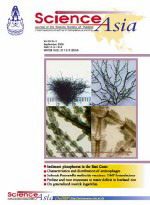ThaiScience
ThaiScience
SCIENCE ASIA
Volume 46, No. 01, Month FEBRUARY, Year 2020, Pages 37 - 45
Biosorption and adsorption of some heavy metals by fusarium sp. f6c isolate as affected by gamma irradiation and agricultural wastes
Ola EA Al-Hagar, Reda A Bayoumi, Osama A Abdel Aziz, Abeer M Mousa
Abstract Download PDF
Various industries produce and discharge wastes containing different heavy metals into the environment. Biosorption as a biological method for removal of heavy metals from industrial and sewage wastewater has attracted the attention of researchers due to its unique properties compared to physical and chemical methods. The purpose of this study is to investigate the fungal biosorption of different heavy metals (lead (Pb), cadmium (Cd), copper (Cu), zinc (Zn), cobalt (Co), and chromium (Cr)) from wastewater. Through the current work, eight fungal isolates have been isolated from wastewater and investigated for their ability to grow in and uptake of different heavy metals. The most potent fungal isolate F6c was identified as Fusarium sp. based on morphological and physiological characterization. The strain F6c has been investigated for its ability to grow at 100 ppm of both PbCl2 and CdCl2. Evaluation of the effect of γ-irradiation on Pb and Cd uptake showed that the biosorption was improved at 1 kGy but gradually suppressed at higher doses. Use of different agricultural wastes including rice bran, rice straw, wheat straw, maize wastes, and bagasse in combination with gamma irradiation improved both PbCl2 and CdCl2 uptake by F6c. Biosorption and adsorption techniques using the irradiation of Fusarium strain F6c could be a potential alternative to conventional methods in terms of availability of materials, cost-effectiveness as biosorbent for removal of high concentration metals from wastewater and industrial effluents
Keywords
adsorption, biosorption, Fusarium sp., heavy metals, mycoremediation, wastewaterSCIENCE ASIA
Published by : The Science Society of Thailand
Contributions welcome at : http://www.scienceasia.org/
